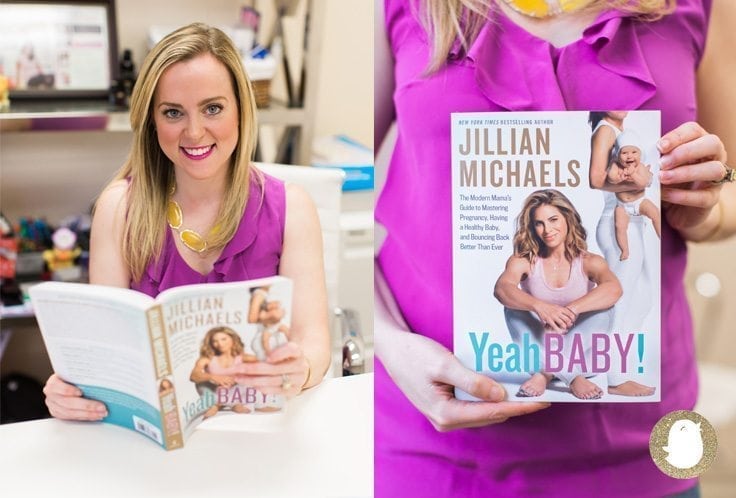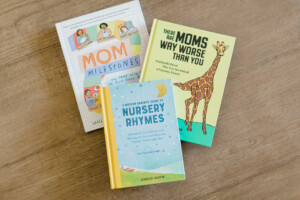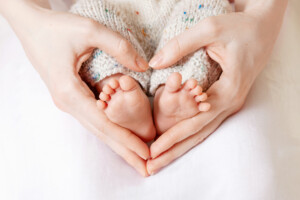I was honored to have the opportunity to interview Jillian Michaels about her new book, Yeah BABY! I didn’t have enough time to read her book before our interview (since I only had two days), but I did have some time to read her book before I published my interview article. I was pleasantly surprised by the helpful information that she provided. There were so many points that I wanted our readers to know that I thought would be beneficial during their pregnancy, so I decided I would do a book review for all of you.
Do you know how CliffsNotes gives you the essentials of literary work? Well, I’m offering Nina’s Notes to provide you with the essential points of each book I read.
Nina’s Notes: Yeah Baby!
At the beginning of the book, Jillian has an Introduction section. Here is where she explains why she wrote this book and the purpose of her book Yeah BABY!
That’s the purpose of this book: to empower you with all the knowledge, facts, and cutting-edge research so that you can best protect yourself and your baby, personalize this process for an ideal outcome, and craft your own pregnancy and birth decisions for you and your baby.
Pregnancy is a sacred responsibility. So much of what you do, eat, think, feel, and surround yourself with–even what you smell!– during this time can have a dramatic effect on you and your baby. Your behaviors now will impact everything from your delivery and how quickly your body “bounces back into shape” to your child’s temperament and behavior, sleep patterns, how your child performs in school, your child’s food preferences, life span–and as I previously mentioned, even long-term earning potential. Seriously! Crazy, right?
I will tell you what’s what, but I won’t tell you what to do. I want you to know your choices and understand what’s happening to ensure you’re in the driver’s seat. … I respect your decisions, even when they go against my recommendations in this book.
I want you to question me, and anyone else, if what they tell you doesn’t feel right to you.
Jillian made me feel comfortable right at the get-go. She introduced her fantastic team in this section, so you know she is not offering information she doesn’t have personal or professional experience with. Her heart is in the right place, and I was looking forward to reading what she had to say.
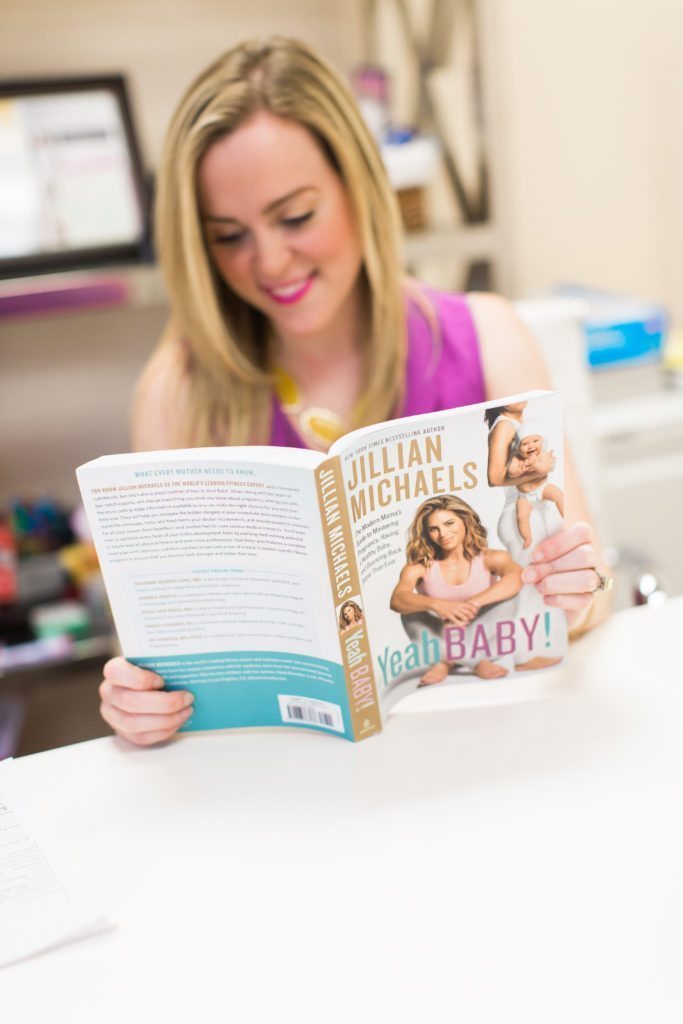
Part 1: Basics
Chapter 1: Start Me Up: What to Do Before You Get Preggers
- If any of you are struggling with infertility (Jillian has PCOS), whether you have been diagnosed with it or you just know, let me say this: It’s not your fault, and shame on anybody who dares to shame you for it. You are just as much a woman as every other woman you know. The journey into motherhood is different for everyone, and there is no way of telling where your journey with the process will take you. It will be okay. It will work out exactly how it’s meant to. I am living proof of that.
Chapter 2: Rules of Thumb: Nutrition for Prepregnancy, Pregnancy, and Beyond
- Nutrition during pregnancy is one of the most direct means that we have to influence our babies’ development, growth, intelligence, fitness, and even life span.
- You are not eating for two.
- It takes only around 80,000 calories — in total — to grow a baby.
- First trimester: 300 extra calories per day if you are very active.
- Second trimester: about 350 extra calories per day.
- The second half of the third trimester (last 6 weeks): about 500 extra calories daily.
- A study found that, compared with children of women who gained the recommended amount of weight, those who gained an “excessive” amount of weight had children who were more than four times more likely to be overweight at age 3. Many studies have shown that birth weight is directly related to later BMI into adolescence and adulthood.
- Here is what you should obviously lessen the consumption of or avoid:
- Alcohol
- Easy on the caffeine
- No deli meat: If you are considering eating deli meats, reheat the meat until it is steaming to kill any possible bacteria.
- No unpasteurized milk or soft cheese: steer clear of soft cheeses such as Brie, Camembert, Roquefort, feta, and gorgonzola, and Mexican-style cheeses like queso blanco and queso fresco unless they clearly state that they are made from pasteurized milk.
- No raw eggs
- No raw meat or fish
- No pâté
- If there is one guideline regarding food quality that I would like in neon, it would be this: Go organic. Going organic is more important than anything you can do for your baby’s health. Organic food is relatively free of dangerous toxic chemicals that have been linked to a host of health-related issues affecting you and your unborn little one.
I also really liked her Nutrient Chart at the end of the chapter. It lists all the nutrients you need, the benefits they have on mom and baby, the daily requirements you need, and good food sources to receive those nutrients.
Chapter 3: Rules of Thumb: Exercise for Prepregnancy, Pregnancy, and Beyond
- Exercise during pregnancy will not hurt your baby. There is strong evidence that it will make your kiddo fitter and smarter!
- Exercise Benefits for Mom:
- Women who exercise during pregnancy gain less weight and put on less body fat, significantly reducing their risk of (or treating their) gestational diabetes.
- Regular, moderate exercise can significantly reduce typical pregnancy discomforts like constipation, indigestion, headaches, backaches, bloating, varicose veins, insomnia, fatigue, and mild to moderate nausea.
- Exercise also eases tension, stress, and anxiety and lowers the risk of premature birth caused by preeclampsia (high blood pressure during pregnancy).
- Women who exercise have significantly shorter push stages (the second stage of labor), and their actual delivery and recovery from delivery are easier.
- Regular exercisers are 75% less likely to need a forceps delivery, 55% less likely to have an episiotomy, and up to four times less likely to have a Caesarean section.
- Their chances of struggling with postpartum depression are also decreased, and exercise generally improves your mood throughout the entire process (and always).
- Working out during pregnancy helps women get their “bodies back” 40% faster than those who don’t.
- If you weren’t exercising before pregnancy, you might even end up with a better body than before you got pregnant.
- Exercise Benefits for Baby:
- Exercise during pregnancy has been shown to help your body grow a healthier placenta due to improved blood circulation. A healthier placenta equals a healthier baby.
- Fit pregnancies also keep the baby at a healthy weight, which is critical to their long-term health.
- Babies of mothers who exercise throughout pregnancy have about half the risk of fetal stress during labor, with better heart-rate patterns and higher APGAR scores (as assessment of a newborn immediately after birth to determine the baby’s health) than the babies of moms who stopped exercising after the first trimester.
- Moms who continued to exercise until their third trimester had labors that were an average of 2 hours shorter—now that’s some serious incentive!
- Babies with fit mamas have lower resting heart rates and greater heart-rate variability, a marker of cardiac and nervous system health.
- Contractions during labor aren’t as stressful for your little one because they are already accustomed to mom working hard physically during the pregnancy.
- Exercising moms have fewer tangled umbilical cords and meconium incidents in the amniotic fluid.
- Children of athletic moms may have greater athletic potential.
- Babies born to moms who exercised during pregnancy have more mature brain development after birth, perhaps giving them a head start in the smarts department.


Jillian covers everything that you want to know when it comes to exercise during pregnancy. She shares what you should wear, how you should warm up and cool down, how long and how often you should exercise, what you should avoid, and how hard you should be exercising by using Borg’s Rating of Perceived Exertion (RPE) Scale.1
Chapter 4: Rules of Thumb: Environment
We like to think our babies come out as clean slates, at least in terms of detrimental exposure to the world. Not so. According to a study spearheaded by the Environmental Working Group, researchers at two separate laboratories found an average of 200 industrial chemicals and pollutants in the umbilical cord blood of babies born in the United States.
It’s upsetting to know that these chemicals and pollutants are introduced to our unborn babies, so Jillian talks about actions that you can take to lower that number.
- Indoor Air Quality
- Indoor air has two to five times more contaminants and, in some cases, even as much as 100 times more contaminants than the air right outside your front door, even if you live in a big city.
- She lists all the crap in the air, how it can affect your child, and what you can do to improve your air quality, such as opening your windows, getting houseplants, banning smoking, not storing harsh chemicals in your house, getting a true HEPA filter, and more.
- Home Decor
- She wants you to reconsider the carpet, remove the lead, air out your paint, and choose your furniture carefully. She even lists some great resources for natural, green furnishings.
- Clean Up the Kitchen
- Upgrading your cookware, losing the bleach, and getting rid of your plastic containers.
- Natural in the Yard
- Skipping the Fire
- Cleaning Products
- We know that many of the ingredients in standard household cleaners can cause everything from acute exposure emergencies (many involving children under 6 years old who swallow or spill these cleaners) to long-term hazards like asthma, lung damage, and heart damage to more minor issues like allergies and headaches.
- Jillian lists the brands she approves and ways to make your own DIY cleaning products.
- Dry Cleaning
- Getting the Best Water
- Electronics
- Personal Hygiene
Part 2: Healthy Pregnancy
Chapter 5: Your First Trimester
Jillian has never been pregnant, so she shares her experience being a partner, and her partner, Heidi, shares her experience as well.
During the first trimester, she starts covering the common symptoms you may experience, such as headaches, morning sickness, gas, fatigue, pregnancy acne, and constipation, as well as ways to remedy them. She lists questions to ask your doctor during your first trimester and breaks down everything happening to your body and your baby during that trimester week-by-week. She goes into detail, so learning about each little change is cool.
My favorite part of the chapter is in the back, where she covers first-trimester nutrition and fitness. Jillian lists all of the nutrition Dos and Don’ts in the nutrition section and even lists out a meal plan with recipes you could eat daily. Including snacks! I particularly love this because it has the ingredients she listed before (which are super important to consume during that trimester) in each recipe. It couldn’t be any easier for you. Amazing!
The same thing goes for the first-trimester fitness section. Jillian explains why you should be working out during the first trimester and how you should be working out. She has a workout plan for you in the book and has pictures of each exercise, so there is no confusion. Now you know how to work out properly and what will be best for you and your baby. I love it!
Chapter 6: Your Second Trimester
Your second trimester is where you may begin (she explains) to experience other symptoms, such as heartburn, pregnancy brain, mood swings, hemorrhoids (or bum bumps as she refers to them), and restless leg syndrome. At least, that’s what her partner, Heidi, experienced. She also states that this is usually the trimester where you feel your best, get a burst of energy, and get your hunger back. Thank goodness, no more nausea (hopefully)! Jillian shares some remedies that can help some of the negative symptoms you are experiencing, which I found super helpful.
Just like in the first trimester, Jillian provides a list of questions to ask your doctor this trimester and even talks about hiring a doula! She and her partner, Heidi, hired a doula, so she offers tips for finding the best doula for you, what interview questions to ask, and things you should consider when hiring one.
Jillian then begins to break down the development of each week in the second trimester and explains what’s happening to you and your baby. She said, “The second trimester is just about getting plenty of rest, eating well, and keeping active.” She also reviews some old wives’ tales and tells whether they are true or false. For example, spicy food can trigger early labor (false), morning sickness will ease up in the second trimester (not always true), and cocoa butter will prevent stretch marks (false). But she does mention that “a healthy diet can also help maintain collagen and possibly prevent or lessen the severity of stretch marks, but unfortunately, the tendency for them also has a genetic component.”
What’s nice is that she goes over all the tests you will be offered during each trimester. She explains when you can expect them and why they are given. This can be reassuring and make any expectant mama feel more relaxed and prepared.
The second-trimester nutrition and fitness plans are also in the back of this chapter, with full recipes, explanations for why you need them (to help get rid of heartburn and lower back pain), and pictures to help you complete your workouts. 🙂
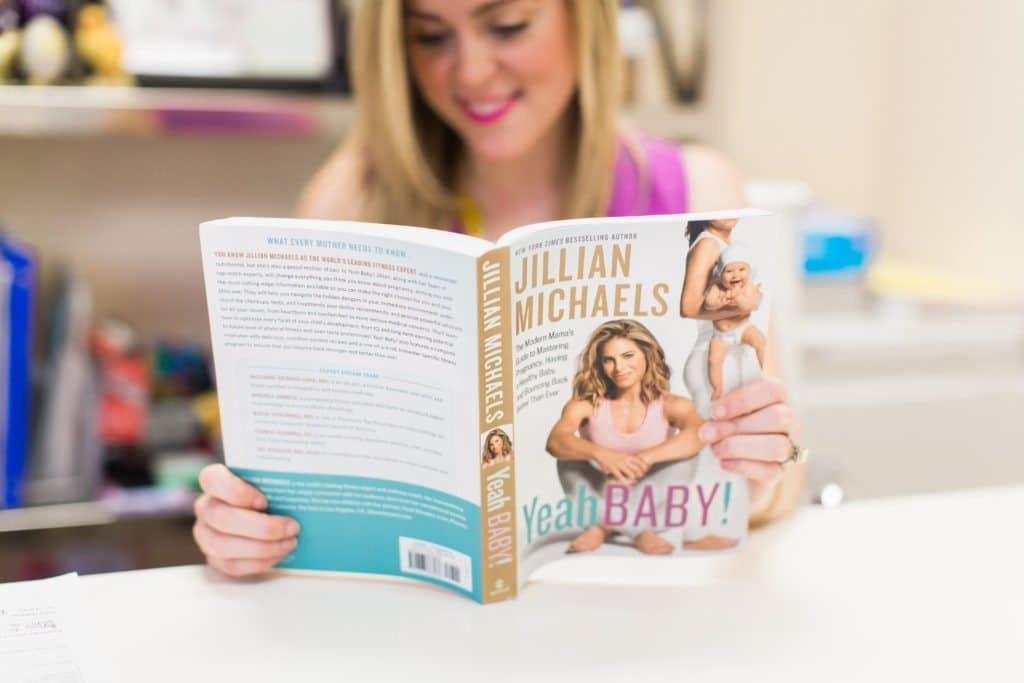
Chapter 7: Your Third Trimester
Things in the third trimester become a bit more uncomfortable, and the symptoms you were feeling in your second trimester can get exacerbated. The constant urge to pee, heartburn, back pain, etc., are all very common during this time of your pregnancy.
Just as in the previous two chapters, Jillian has a list of questions to ask your doctor or midwife, and she breaks down your pregnancy week by week.
She also briefly covers birth plans in this chapter:
- Birth Plan
- A written-down plan for how you would like things to go during labor and delivery.
- The purpose is to think about and plan for things you can’t just decide on at the last minute when you are already in labor.
- Keep it brief.
- Flexibility is important.
And like the previous chapters, it ends with a helpful third-trimester nutrition meal plan and fitness routine.
Part 3: Family
Chapter 8: Labor and Delivery
I was most curious about reading this chapter since I have been to hundreds of births. I wondered if she would give her recommendations after just attending and witnessing one birth. This doesn’t make her an expert. Of course, she gave her opinion in the book, but I was pleased that she also listed other options available to families rather than just listing her preferences.
At the beginning of this chapter, Jillian says that Heidi desperately wanted a natural birth (no-pain medication/ vaginal birth). Heidi had done tons of research, hired a doula, and prepared for a natural birth during her pregnancy. Jillian likes to mention that no matter your decision on how you will have your baby, “You are never going to win in the eyes of others. The way to win is to do what is best for you.” I loved that. More women need to know that when preparing for their birth.
She continued with Heidi’s birth story and what happened to her. Essentially, Heidi went past her due date (a little over a week), needed to be induced, had her water broken after several hours of no dilation, then after 13 hours received an epidural, and then after 27 hours had a C-section since her cervix never dilated past 4 cm. Her baby boy was 9 pounds. They said that her tiny frame (she is 5’2″ and usually 100 lbs, not pregnant) wouldn’t allow her baby to drop and apply pressure on her cervix, allowing it to dilate. This is why Jillian states that you must be flexible on your birth plan because things will probably not go the way you plan.
Later in the chapter, Jillian then asks you things to consider to have the birth you want. Things that she said to consider:
- Doctor or midwife?
- Birthing environment: home birth, birth center, hospital?
- Inducing labor: membrane stripping or sweeping, amniotomy (breaking your water), cervical dilators, and Pitocin?
- Water birth
- Placenta encapsulation
- Pain management: epidural, spinal, IV narcotics, general anesthesia, and local anesthesia?
- C-section vs. Vaginal Birth?
- Episiotomies
- Forceps or Vacuum extractors?
Jillian also then briefly covers what happens after the birth. Even her pediatrician, Dr. Gordon, said the antibiotic eye treatment “is unnecessary.” However, they do cover how Vitamin K is beneficial and important. My favorite thing Dr. Gfordon said was, “Minimize visitors who are not there to bring food, rub your neck, or clean your kitchen or bathroom?” He’s my hero!!
Chapter 9: Your Fourth Trimester
In this chapter, I love how Jillian is super real. She states, “The fourth trimester can be the hardest one of all.” Ain’t that the truth. And I find it the one most expecting parents prepare for the least. Jillian talks about baby blues and postpartum depression, how to remember your partner in parenthood (I loved that part — partners are often pushed aside), and she tells you to remember that you are human. There were several “favorites” of mine in this chapter, and one of them is this:
Pregnancy and postpartum are real hot-button issues for some people, who might be terrified to speak their truths and share their stories with candor, for fear that if they admit they’ve experienced anything other than total and complete mind-blowing bliss they are bad moms or not “normal.” Are you a “bad mother” if you worry about your waistline or your weight gain? If you don’t always want to hold the baby? If you don’t enjoy breastfeeding like you hoped you would? If you worry you might be all wrong for this “mother” job? If you are struck with the fear, in the wee small hours of the night, that this whole “having a baby” thing was a horrible mistake? If you sometimes feel like you would trade your loving and supportive partner for a solid 8 hours of sleep? Nope. Again, all normal. Women through the ages have felt all these feelings and more, and they are a sign of only one thing: That you are human
Amen to that! I genuinely feel that more women need to hear or read this right after having a baby so they do not feel guilty for their thoughts and do not feel alone.
Jillian also covers how every parent will make mistakes and that you will receive unsolicited parenting advice from pretty much anyone and everyone. She says, “Take it all with a grain of salt and refrain from assaulting them if you can. Remind yourself: they aren’t worth the jail time.” haha! She also covers pumping, breastfeeding (mastitis, latch issues, sore or cracked nipples, thrush, low milk supply), bottle-feeding, and the three S’s: Sleep, Support, and Sustenance during this trimester and how to receive more of it.
I love how she writes, “The point is not to be perfect—never to be perfect. The point is to learn how to forgive yourself, learn from your mistakes, stay open to change, and be okay with your feelings (whatever they may be). That is what a good parent does.”
At the end of the chapter, she writes about nutrition and fitness after baby. I was particularly impressed with how she went over your ideal diet (when and what you should be eating) if you are breastfeeding or bottle-feeding your baby. The same goes for the fitness routine. She had different recommendations on when to work out and how to work out if you had a vaginal (no complications) birth, a c-section, if you had an episiotomy or tearing, or if you have diastasis recti. Everything was in-depth but easy to pick up and understand. I was very impressed.
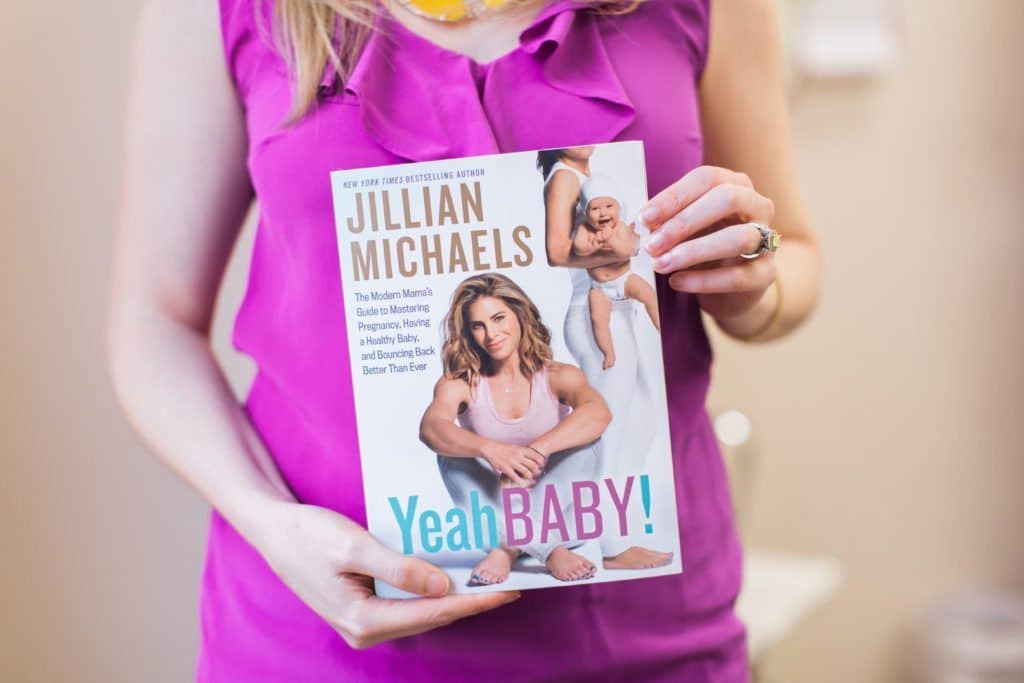
Now you know all about the book! You know what the best parts are, what you can expect, and if it’s something you want to read and recommend. I hope you enjoyed my Nina’s Notes.























